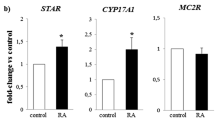Abstract
A LARGE body of evidence implicates adenylate cyclase and cyclic AMP as mediators of adrenocorticotropic hormone (ACTH)-stimulated adrenal steroidogenesis (see ref. 1 for review). Recent observations, however, suggest that ACTH acts at separate sites to increase steroidogenesis and cyclic AMP accumulation, and that cyclic AMP may not be an important component of ACTH-stimulated steroidogenesis2–5. An ACTH-responsive adrenocortical tumour cell line6 (clone Y1) and a derivative clone insensitive to ACTH7 (clone Y6), have been used to examine the role of adenylate cyclase and cyclic AMP in adrenal steroidogenesis1,7. Y6 cells do not respond to ACTH with increased steroidogenesis but do respond to added cyclic AMP7. In addition, these cells have an adenylate cyclase system insensitive to ACTH, probably accounting for their variant phenotype1. Y6 cells, when grown as tumours, regain the ability to respond to ACTH with increased steroidogenesis, and continue to express the ACTH-sensitive phenotype after prolonged periods in culture and extensive dilution7. Y6 cells, after animal passage, provide a system of phenotypic revertants to examine the linkage of different biochemical events to ACTH insensitivity7,8. We have now examined adenylate cyclase activity in phenotypic revertants of Y6 cells induced by animal passage to assess the role of this enzyme in steroidogenesis. After animal passage, Y6 cells regained the ability to respond to ACTH both with increased steroidogenesis and with increased adenylate cyclase activity. These data indicate that the actions of ACTH on adenylate cyclase activity and steroidogenesis are closely linked.
Similar content being viewed by others
References
Schimmer, B. P., J. biol. Chem., 247, 3134–3138 (1972).
Rubin, R. P., Carchman, R. A., and Jaanus, S. D., Biochem. biophys. Res. Commun., 47, 1492–1497 (1972).
Moyle, W. R., Kong, Y. C., and Ramachandran, J., J. biol. Chem., 248, 2409–2417 (1973).
Sharma, R. K., Ahmed, N. K., Sutliff, L. S., and Brush, J. S., FEBS Lett., 45, 107–110 (1974).
Sayers, G., et al., Proc. Soc. exp. Biol. Med., 145, 176–181 (1974).
Yasumura, Y., Buonassisi, V., and Sato, G., Cancer Res., 26, 529–535 (1966).
Schimmer, B. P., J. cell. Physiol., 74, 115–122 (1969).
Murray, R. K., Yogeeswaran, G., Sheinin, R., and Schimmer, B. P., in Tumor Lipids: Biochemistry and Metabolism (edit. by Wood, R.), 285–302 (American Oil Chemists' Society, Illinois, 1973).
Kowal, J., and Fiedler, R., Archs Biochem. Biophys., 128, 406–421 (1968).
Krishna, G., Weiss, B., and Brodie, B. B., J. Pharmac. exp. Ther., 163, 379–385 (1968).
Hayflick, L., Tex. Rep. Biol. Med., Suppl. 1, 285–303 (1965).
Stanbridge, E., Bact. Rev., 35, 206–227 (1971).
Author information
Authors and Affiliations
Rights and permissions
About this article
Cite this article
SCHIMMER, B. Adenylate cyclase activity and steroidogenesis in phenotypic revertants of an ACTH-insensitive adrenal tumour cell line. Nature 259, 482–483 (1976). https://doi.org/10.1038/259482a0
Received:
Accepted:
Issue Date:
DOI: https://doi.org/10.1038/259482a0
- Springer Nature Limited





